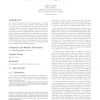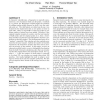8 search results - page 1 / 2 » Lower bounds for collusion-secure fingerprinting |
CORR
2006
Springer
13 years 4 months ago
2006
Springer
Abstract--We address the maximum attainable rate of fingerprinting codes under the marking assumption, studying lower and upper bounds on the value of the rate for various sizes of...
SODA
2003
ACM
13 years 6 months ago
2003
ACM
Collusion-secure fingerprinting codes are an important primitive used by many digital watermarking schemes [1, 10, 9]. Boneh and Shaw [3] define a model for these types of codes...
SIGMOD
2003
ACM
14 years 4 months ago
2003
ACM
Digital content is for copying: quotation, revision, plagiarism, and file sharing all create copies. Document fingerprinting is concerned with accurately identifying copying, incl...
STOC
2003
ACM
14 years 4 months ago
2003
ACM
We construct binary codes for fingerprinting. Our codes for n users that are -secure against c pirates have length O(c2 log(n/ )). This improves the codes proposed by Boneh and Sh...
CCS
2006
ACM
13 years 8 months ago
2006
ACM
In biometric identification, a fingerprint is typically represented as a set of minutiae which are 2D points. A method [4] to protect the fingerprint template hides the minutiae b...


